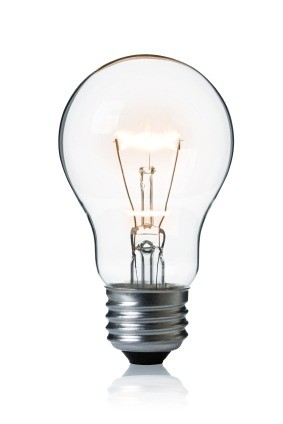Now although the answer to this question might seem a little obvious, some gradual changes have crept in over the past few years that have changed the way that we buy our lamps. This is because the old style tungsten lamps that we’ve been used to have been phased out. For some time its hasn’t been possible to use tungsten lamps within Part L calculations in order to achieve building regulations compliance, but now, due to EU legislation, the lamps in existing buildings will meet higher standards as they are replaced.
There are advantages to the new style lamps – ‘The Energy Saving trust’ say that up to £55.00 per lamp can be saved in running costs over the new lamp’s life time. With a little knowledge, the new style lamps can be pretty good, although we need to think a little more about what we need from our lamps before we buy.
Old style tungsten lamp.
 Previously it has been quite simple. Generally, we’ve bought either a 40, 60, or 100 watt lamp and made sure it would fit into our light fitting (either bayonet or screw-in cap).
Previously it has been quite simple. Generally, we’ve bought either a 40, 60, or 100 watt lamp and made sure it would fit into our light fitting (either bayonet or screw-in cap).
Although that all seemed to work quite well, most of us would have been unaware that the design of tungsten lamps had hardly changed for 120 years and that by modern standards they were giving us poor value for money in terms of running costs. An old style tungsten GLS lamp can lose around 95% of the energy it uses.
But many people have found themselves criticizing low energy lamps (finding they were too dim, too slow to switch on or that the lamp’s white tint is similar to the inside of a fridge).
For those people, the steps below should be useful and help to overcome the shortfalls. In addition, where new lamps have the potential to last 25 years, its worth getting the right lamp from the outset.
All the information we need about the lamp is usually printed on its packaging or on the lamp itself.
Step 1: Get the brightness right
Its easiest to judge this by the wattage. Most of us understand how bright an old style 40, 60 or 100 watt lamp is and keeping this in mind, below is how low energy lamps compare.
Old style tungsten lamp |
New low energy lamps |
| 25 watt | 5 watt |
| 35 watt | 6 watt |
| 40 watt | 9 watt |
| 50 watt | 10 watt |
| 60 watt | 13 watts |
| 100 watt | 23 watts |
Step 2: The right type of Cap
We’ve always had to consider the type of cap. You need to check the size and type of cap on the lamp that you’re replacing – then main choices are between screw-in (E27), Bayonet cap (BC22) as well as small versions (SES and SBC). Spot lamps are generally GU10 or MR16. In short – make sure the new lamp will fit the lampholder in your light fitting.
Step 3: Switching on speed
Some lamps are slow to switch on with a few seconds delay and this needs to be considered. A delay may be fine within an internal corridor that is lit during work hours but in a residential situation it could be inconvenient.
The switching on speed is marked on the packaging of most low energy lamps, often being denoted by a timer symbol.
Step 4: Warmth – check out the ‘k’ number on the packaging
Many people feel a cold appearance is noticeable with low energy lamps. That’s most likely because a lamp has been used with a colour temperature that isn’t suitable for the area they plan to light.
The colour temperature is marked by a ‘K’ number on the lamps packaging. A low ‘K’ number would produce a warm light which may be suited best to say a restaurant or living accommodation and a high ‘K’ number would produce a colder light such as a medical practice or a commercial kitchen might need.
As a rough guide, the old style tungsten lamps had a colour temperature of around 2800k and a fluorescent strip light might have had a colour temperature of around 6000k.
Step 5: Is your light switch dimmable?
If a low energy lamp is dimmable then a dimming logo will be somewhere on the box otherwise its best to assume it cannot be dimmed.


